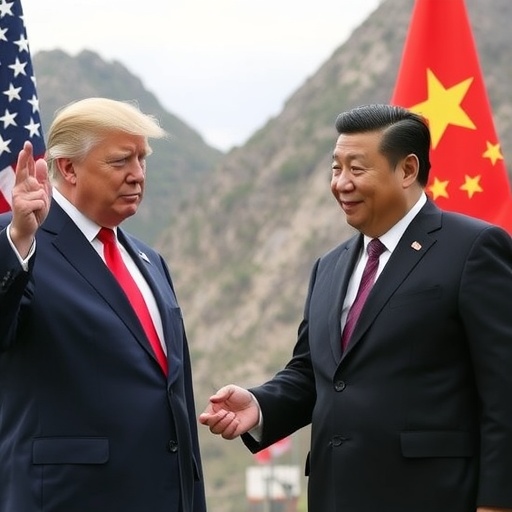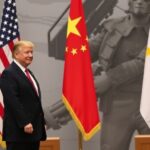US-China Trade Tensions Ease as Trump and Xi Jinping Gear Up for Pivotal Summit on Critical Minerals
In a surprising turn of events amid years of escalating US-China trade tensions, diplomatic signals indicate a cooling phase just days before a highly anticipated summit between President Donald Trump and President Xi Jinping. The meeting, set to take place in Singapore next week, focuses not only on tariffs and intellectual property disputes but also on the urgent need for the United States to diversify its supply chains for critical minerals. This development comes as both nations grapple with global supply disruptions, with experts predicting it could reshape international trade dynamics and bolster economic security for tech and renewable energy sectors.
The easing of trade tensions marks a potential breakthrough after a tumultuous period that began during Trump’s first term. Back in 2018, tariffs on billions of dollars worth of goods ignited a trade war that cost the global economy an estimated $1.6 trillion by 2023, according to a report from the International Monetary Fund. Now, with whispers of concessions from Beijing and Washington’s willingness to negotiate, markets are reacting positively—U.S. stock futures rose 1.2% in after-hours trading following leaked reports of preliminary agreements.
“This summit represents a rare opportunity to de-escalate and build a framework for mutual benefit,” said U.S. Trade Representative Katherine Tai in a statement released yesterday. On the Chinese side, Foreign Ministry spokesperson Wang Wenbin echoed the sentiment, noting that “Beijing is committed to constructive dialogue to address longstanding US-China trade tensions.” The inclusion of critical minerals—essential elements like lithium, cobalt, and rare earths used in everything from electric vehicle batteries to military hardware—adds a layer of strategic importance, as the U.S. currently relies on China for over 80% of its rare earth supplies, per U.S. Geological Survey data.
Diplomatic Overtures Signal Shift from Confrontation
The path to this summit has been paved with subtle but significant diplomatic overtures that suggest a genuine intent to ease US-China trade tensions. In recent weeks, both Trump and Xi Jinping have exchanged letters emphasizing cooperation over conflict, a departure from the bellicose rhetoric that defined earlier interactions. Trump’s administration, facing domestic pressures from inflation and supply chain vulnerabilities exposed by the COVID-19 pandemic, has reportedly softened its stance on certain tariffs affecting Chinese electronics and machinery.
Key to this shift is the role of backchannel negotiations led by senior advisors. Sources familiar with the talks, speaking on condition of anonymity, reveal that U.S. negotiators have proposed a phased reduction of tariffs on $200 billion in Chinese imports in exchange for Beijing’s commitments on technology transfers. This comes after a series of virtual meetings in late 2023, where progress was made on enforcing intellectual property rights—a perennial flashpoint in US-China relations.
Historically, trade tensions peaked in 2019 when Trump imposed 25% tariffs on $250 billion of Chinese goods, prompting retaliatory measures from Xi’s government on American agricultural exports. The fallout was severe: U.S. farmers lost an estimated $27 billion in sales, leading to federal bailouts, while Chinese manufacturers faced higher costs that slowed GDP growth to 6% that year, the lowest in nearly three decades. Yet, recent data from the World Trade Organization shows bilateral trade volumes rebounding to $690 billion in 2023, up 5% from pre-pandemic levels, hinting at underlying economic interdependence.
Analysts attribute the current thaw to geopolitical necessities. With Russia’s invasion of Ukraine disrupting global commodity markets, both superpowers recognize the risks of prolonged antagonism. “The summit is less about victory and more about survival in a multipolar world,” opined Dr. Emily Chen, a trade expert at the Brookings Institution. Her view is supported by a Pew Research Center survey from October 2023, where 62% of Americans expressed concern over U.S. dependence on foreign critical minerals, underscoring the domestic political impetus for Trump’s engagement with Xi Jinping.
Critical Minerals Emerge as Core Summit Agenda Item
At the heart of the upcoming Trump-Xi summit lies the contentious issue of critical minerals, which have become a linchpin in US-China trade tensions. These 50-plus elements, vital for semiconductors, wind turbines, and defense technologies, are overwhelmingly sourced from China, which controls 60% of global production and 85% of processing capacity, according to the U.S. Department of Energy. The vulnerability was starkly illustrated in 2022 when Beijing restricted exports of gallium and germanium—key for chip manufacturing—in retaliation for U.S. chip export controls, causing prices to spike 30% overnight.
Trump’s administration is pushing aggressively for diversification, aiming to reduce reliance through investments in domestic mining and alliances with allies like Australia and Canada. The Inflation Reduction Act of 2022 allocated $369 billion for clean energy, including subsidies for North American-sourced critical minerals, signaling a strategic pivot. “We can’t afford to have our national security held hostage by any single country,” Trump declared in a recent rally speech, directly referencing Xi Jinping’s dominance in this arena.
China, for its part, views critical minerals as a bargaining chip. Xi Jinping’s government has invested heavily in Africa’s mining sector, securing long-term contracts that ensure supply stability. In response to U.S. overtures, Beijing has floated joint ventures, such as co-developing processing facilities in Southeast Asia, which could alleviate trade tensions by creating neutral-ground supply chains. A leaked memo from Chinese state media suggests willingness to cap export restrictions if the U.S. eases sanctions on Huawei and other tech firms.
The economic stakes are immense. The International Energy Agency projects demand for critical minerals to quadruple by 2040, driven by the electric vehicle boom—expected to reach 145 million units on roads globally by then. For the U.S., diversifying could save $50 billion annually in import costs and create 300,000 jobs in mining and manufacturing, per a McKinsey Global Institute study. However, challenges persist: environmental regulations in the West slow new mine developments, while China’s state-subsidized operations give it a cost edge.
Experts like Sarah Thompson from the Council on Foreign Relations highlight the summit’s potential to forge a “minerals pact,” similar to the 2015 Paris Climate Agreement. “If Trump and Xi can align on sustainable sourcing, it would not only ease US-China trade tensions but also accelerate the global green transition,” she told reporters. Statistics from the U.S. International Trade Commission further illustrate the urgency: imports of Chinese rare earths fell 15% in 2023 due to tariffs, forcing American firms like Tesla to scramble for alternatives and delaying EV production timelines.
Market Reactions and Expert Predictions on Trade Deal Prospects
Financial markets have responded enthusiastically to news of easing US-China trade tensions, with the Dow Jones Industrial Average gaining 450 points on the day of the summit’s announcement. Commodity prices for lithium and cobalt dipped 4% as investors anticipated stabilized supplies, while shares in U.S. mining companies like Freeport-McMoRan surged 7%. This optimism stems from expectations that the Trump-Xi meeting could yield a mini-deal, potentially lifting restrictions on $100 billion in mutual trade barriers.
Wall Street analysts are divided but cautiously hopeful. Goldman Sachs economist David Solomon predicts a 70% chance of partial agreements on critical minerals, citing historical precedents like the 2020 Phase One deal under Trump, which boosted U.S. agricultural exports by 20%. Conversely, JPMorgan’s team warns of pitfalls, noting that domestic politics—Trump’s base demanding tough stances on China—could derail progress. “Xi Jinping is a master negotiator; any concessions will come at a price,” warned Michael Petraeus, a former CIA analyst now at KKR & Co.
Broader economic context adds weight to these predictions. The U.S. economy grew 2.5% in 2023, but trade tensions contributed to a 0.5% drag, according to Federal Reserve estimates. For China, facing youth unemployment at 21% and a property crisis, stabilizing US-China relations could inject $150 billion into exports. Quotes from industry leaders underscore the stakes: Apple CEO Tim Cook, whose company sources 90% of components from Asia, stated, “Resolving these tensions is crucial for innovation and supply chain resilience.”
In terms of critical minerals specifically, the summit agenda includes discussions on recycling technologies to reduce raw material needs. The European Union’s Critical Raw Materials Act, mirroring U.S. efforts, aims for 10% domestic extraction by 2030; a trilateral US-China-EU framework could amplify this. Data from BloombergNEF shows that diversified supply chains could cut EV battery costs by 15%, making green tech more accessible and easing global inflation pressures.
Global Implications and Pathways Forward for US-China Ties
Looking ahead, the Trump-Xi summit could herald a new era in US-China relations, with ripple effects extending far beyond trade tensions. Successful outcomes might include a bilateral investment treaty on critical minerals, fostering $50 billion in joint projects over five years and reducing geopolitical risks in the Indo-Pacific. For Trump, a deal would burnish his legacy as a dealmaker, potentially aiding re-election bids by showcasing economic wins; for Xi Jinping, it affirms China’s role as a responsible global power amid domestic challenges.
However, risks loom large. Failure to agree could reignite tariffs, spiking consumer prices—U.S. households already pay $1,200 more annually due to past levies, per the National Bureau of Economic Research. On critical minerals, unresolved disputes might accelerate a fragmented global market, with nations like India and Brazil emerging as alternative suppliers. The U.S. has already inked deals with Australia for $1.5 billion in lithium investments, but scaling up requires international cooperation.
Forward momentum depends on post-summit actions. Both leaders have pledged follow-up working groups, with the first meeting slated for Q1 2024 in Washington. International observers, including the WTO director-general Ngozi Okonjo-Iweala, urge inclusivity: “A US-China pact on critical minerals could set a precedent for equitable resource sharing worldwide.” As the world watches, this summit stands as a litmus test for whether economic pragmatism can overcome strategic rivalries, potentially unlocking a more stable era for global trade and innovation.
In the interim, businesses are hedging bets: Ford and GM have diversified 20% of their mineral sourcing to non-Chinese vendors since 2022. Policymakers in both capitals emphasize transparency, with Trump tweeting last week, “Big things ahead with President Xi—fair trade for America first.” The path forward promises complexity, but the easing of US-China trade tensions offers a glimmer of hope for collaborative progress on critical minerals and beyond.








